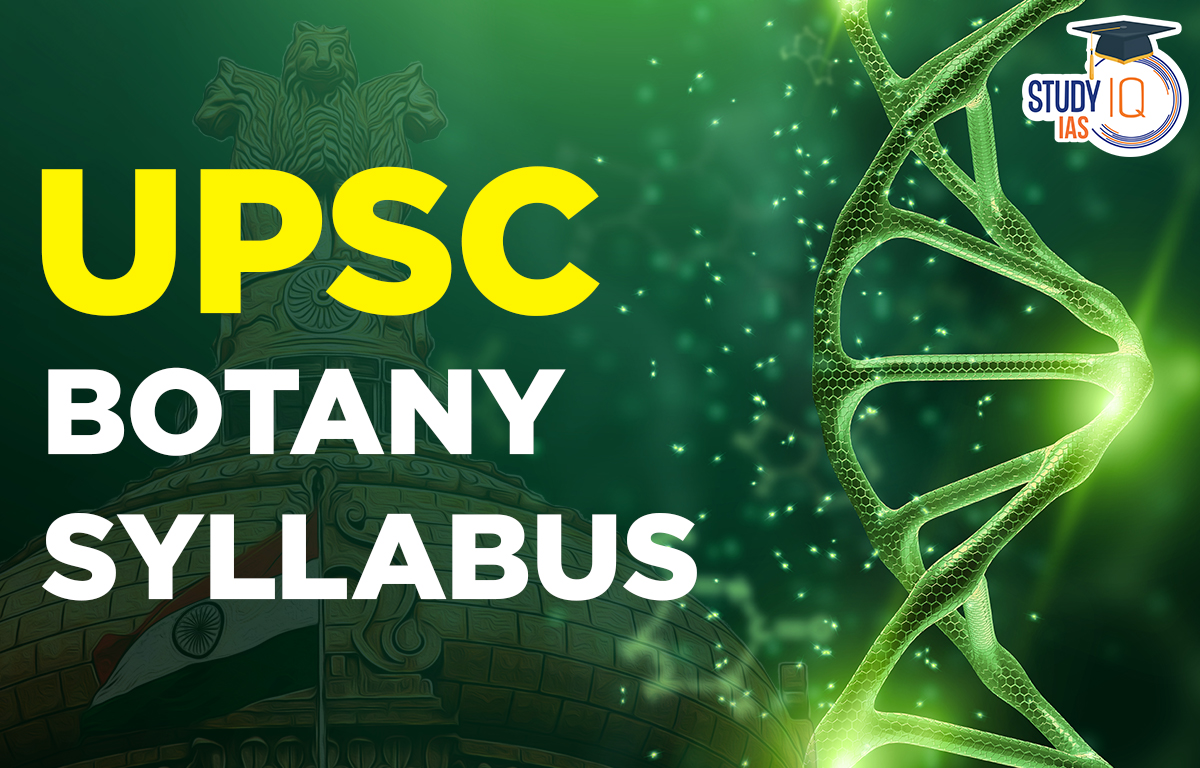Table of Contents
UPSC Botany Syllabus
Botany is one of 48 optional subjects offered by the UPSC, and it is one of those subjects. The IAS Exam’s Botany syllabus measures candidates’ comprehension of the topic as a science and their ability to use their knowledge of plants to solve ecological issues. This course covers both theoretical and practical aspects of botany.
Candidates who have studied Botany as part of their curriculum or have a strong background in plant biology should take this option because it is a highly specialised subject. This article contains a detailed UPSC Botany Syllabus for the IAS Mains Exam.
Read More: UPSC Syllabus
UPSC Botany Optional Syllabus
In the civil services examination, this subject has two papers (paper I and paper II). Each paper carries 250 marks and a total of 500 marks. UPSC Mains consists of nine subjective papers, two of which are optional subjects that a candidate may choose.
Read More: UPSC History Syllabus
UPSC Botany Syllabus Optional Paper I
| Topic | Detailed Syllabus |
|---|---|
| 1. Microbiology and Plant Pathology | Structure and reproduction/multiplication of viruses, viroids, bacteria, fungi, and mycoplasma; Applications in agriculture, industry, medicine; Soil and water pollution control; Prion and prion hypothesis. Crop diseases: viruses, bacteria, mycoplasma, fungi, nematodes; Infection/dissemination; Molecular basis of infection and resistance; Physiology of parasitism; Control measures; Fungal toxins; Disease forecasting and quarantine. |
| 2. Cryptogams | Algae, fungi, lichens, bryophytes, pteridophytes – structure and reproduction with evolutionary perspective; Distribution in India; Ecological and economic importance. |
| 3. Phanerogams | Gymnosperms: Progymnosperms, classification, distribution; Features of Cycadales, Ginkgoales, Coniferales, Gnetales; Structure and reproduction. Cycadofilicales, Bennettitales, Cordaitales; Fossil types and techniques; Geological time scale. Angiosperms: Systematics, anatomy, embryology, palynology, phylogeny; Classification systems; ICBN, chemotaxonomy, numerical taxonomy; Study of families: Magnoliaceae, Ranunculaceae, Brassicaceae, etc. Structure: Stomata, trichomes, secondary growth, C3/C4 anatomy, xylem-phloem, wood anatomy. Reproduction: Gametophytes, pollination, fertilization, endosperm, embryo development, polyembryony, apomixis, experimental embryology. |
| 4. Plant Resource Development | Domestication, plant introduction, Vavilov centers; Plants for food, fiber, oil, spices, medicine, etc.; Gums, dyes, latex, cellulose, starch; Ethnobotany; Botanical gardens, herbaria; Energy plantations. |
| 5. Morphogenesis | Totipotency, polarity, symmetry, differentiation; Cell/tissue/organ/protoplast culture; Somatic hybrids, cybrids; Micropropagation; Somaclonal variation; Pollen haploids; Embryo rescue techniques. |
UPSC Botany Syllabus Optional Paper II
| Topic | Detailed Syllabus |
|---|---|
| 1. Cell Biology | Cell biology techniques; Prokaryotic/eukaryotic structure; ECM, membranes, organelles; Cytoskeleton; Nucleus, chromatin, nucleosome; Cell signaling, receptors; Signal transduction; Cell cycle, mitosis/meiosis; Chromosomal variations; Genome packaging; Polytene and B-chromosomes. |
| 2. Genetics, Molecular Biology, and Evolution | Gene vs allele, pseudoalleles; Quantitative/multiple factor inheritance; Polygenic traits; Linkage, crossing over, mapping; Sex determination/inheritance; Mutations; Cytoplasmic inheritance; Nucleic acid/protein synthesis; Genetic code; Gene regulation, silencing; RNA role in evolution; Organic evolution theories. |
| 3. Plant Breeding, Biotechnology, and Biostatistics | Plant breeding methods: introduction, selection, hybridization, mutation, polyploidy, heterosis, apomixis; Transgenics, biosafety; Molecular markers, DNA sequencing; Tools: blotting, PCR, FISH, fingerprinting. Biostatistics: SD, CV, Z-test, t-test, chi-square; Probability (normal, binomial, Poisson); Correlation, regression. |
| 4. Physiology and Biochemistry | Water/mineral nutrition, transport, deficiencies; Photosynthesis (C3/C4/CAM), photophosphorylation; Phloem transport; Respiration (aerobic/anaerobic), ETC; Photorespiration, chemiosmosis; Lipid/nitrogen metabolism; Enzymes, coenzymes; Secondary metabolites; Pigments, photoperiodism, vernalization; Hormones (auxins, gibberellins, etc.); Stress physiology; Seed dormancy/germination; Fruit ripening. |
| 5. Ecology and Plant Geography | Ecosystems, ecological factors, succession, community dynamics; Biosphere, conservation, pollution, phytoremediation, indicators; Environment Act; Forest types of India; Endangered plants, IUCN, Red Data Books; Biodiversity, protected areas, CBD, IPRs, Farmers’ Rights; Sustainable development; Biogeochemical cycles; Climate change, invasive species, EIA; Phytogeographical regions of India. |
IAS aspirants should be aware that Botany for UPSC may increase their chances of selection. So, in order to do well on this paper, thorough preparation is required. To crack the UPSC Botany syllabus, candidates should solve more questions from previous years’ UPSC question papers as well as mock tests.
UPSC Botany Optional Preparation Strategy – Key Points
Strategy Overview
-
Understand the syllabus: Divide Paper I & II into sub-topics.
-
Set a timeline: Allocate time for study, revision, and practice.
-
Focus on core areas:
-
Paper I: Plant Pathology, Morphology, Anatomy, Embryology
-
Paper II: Physiology, Genetics, Ecology, Cell Biology
-
Daily Study Plan
| Task | Time Allocation |
|---|---|
| Theory Reading | 3–4 hours |
| Diagram Practice | 1 hour |
| Answer Writing | 1–2 hours |
| Revision | 1 hour |
| PYQ Analysis | Weekly (2–3 hours) |
Answer Writing Tips
-
Start after 50% syllabus completion.
-
Use neat diagrams and flowcharts (e.g., C3 vs. C4 cycle).
-
Refer to topper copies for format and structure.
Recommended Books
| Paper I | Paper II |
|---|---|
| Prescott’s Microbiology | Karp’s Cell Biology |
| Plant Pathology – Agrios | Genetics – Klug & Cummings |
| Botany – Singh, Pandey & Jain | Plant Breeding – B.D. Singh |
| Gymnosperms – Bhatnagar & Moitra | Biotechnology – B.D. Singh |
| Plant Anatomy – B.P. Pandey | Plant Physiology – Taiz & Zeiger |
| Economic Botany – S.L. Kochhar | Ecology – P.D. Sharma |


 List of Governor of States in India, Con...
List of Governor of States in India, Con...
 Daily Quiz 15 July 2025
Daily Quiz 15 July 2025
 Maratha Military Landscapes of India Add...
Maratha Military Landscapes of India Add...





















